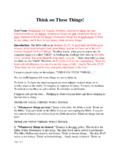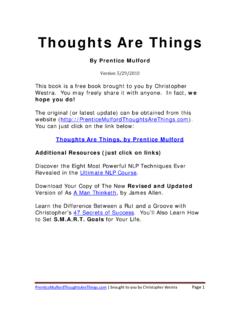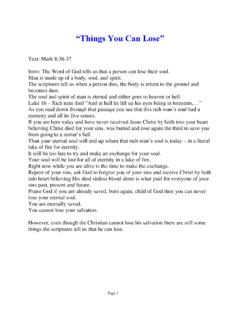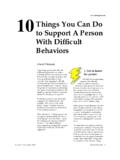Transcription of Getting Things Done: The Art of Stress-Free …
1 Getting Things done : The Art of Stress-Free ProductivityThis week, Life Training Online will be reviewing Getting Things done : The Art of Stress-Free Productivity by David Allen, the third of fifty-two books in the 52 Personal Development Books in 52 Weeks those involved in learning about personal productivity, the GTD ( Getting ThingsDone) phenomenon is probably nothing new to you and this week s review willprobably be old hat. But if you ve never heard of it, be prepared to learn some skillsthat will simplify your life and cause your personal productivity to take a quantumleap!
2 The GTD following has become so huge that, according to Wired Magazine, it is thenew cult for the information age . There are even entire sites built upon the principlesDavid Allen sets forth in his book. Some notable ones being 43 Folders and main principle behind GTD, which I will cover in detail, involves moving your tasks out of your mind by recording them somewhere. That way, the mind is freed from having to remember everything that needs to be done , and can concentrate on actually performing those it might seem that Allen s system was created solely for today s knowledgeworker in the professional environment, you will see that it is just as applicable toone s home environment and projects as well.
3 So stay Things done is the third of fifty-two books in Life Training - Online s series 52 Personal Development Books in 52 Things done : The Art of Getting Things DoneThis week, Life Training Online will be reviewing Getting Things done : The Art of Stress-Free Productivity by David Allen, the third of fifty-two books in the 52 Personal Development Books in 52 Weeks we ll be visiting the first three chapters that make up the first part of GTD: TheArt of Getting Things DoneA New Practice for a New RealityAs society changes from the industrial-age model to the age of the knowledgeworker , new tools and ways of executing one s day-to-day tasks are required.
4 Andparadoxically, as we find our quality of life increasing and discover more time, we endup taking on more tasks than we have the resources to handle. This combined withour jobs becoming less and less specific as to what our role entails, we take on evenmore responsibility and are left with too much input and not enough throughput. Allof which leaves our productivity far from optimal, and our lives and our mindsover-cluttered, overworked, and solution to this problem, can found in Allen s methodology on Getting ThingsDone (GTD): First, capture everything you need to accomplish somewhere outside ofyour brain and second, discipline yourself to make decisions about these tasks asthey are added to your productivity can then be found when the mind is clear, free of what he calls open loops the Things you commit to do but remain unfinished, putting a strain onyour unconscious mind.
5 Allen compares the mind to a computer s RAM, where toomuch stuff stored in your short-term memory can blow a fuse. The conscious mind isintended as a focusing tool, not a storage Control of Your Life: The Five Stages of Mastering Workflow In order to take back control of your life (if you ever were in control ), you must learn the five stages of mastering workflow: to collect, process, organize, review and do. During the Collection stage, your main goal is to gather all the tasks that you have onyour plate, get them out of your head, and put them into Collection Tools itemssuch as your physical in-basket, paper-based and electronic note-taking devices,voice-recording devices and email.
6 In order to be successful during the Collectionstage, Allen specifies three rules that must be followed: 1. Every open loop must bein your collection system and out of your head. 2. You must have as few collectionbuckets as you can get by with. 3. You must empty them the Process stage, you start going through and emptying those buckets aprocess that he outlines throughout the book in great s an overview:What is it? Is it actionable?If not, trash it, put it in a tickler file (I ll be talking about this tomorrow) or put itin a reference so, what s the next action?
7 The next action is defined as the next physical,visible activity that needs to be engaged in, in order to move the current realitytoward next action take less than 2 minutes? If yes, do no, delegate it or defer it will take longer than 2 minutes, consider it a project (defined as requiring more than one action step) and put it in your project plans which will be reviewed for Organize stage becomes the input of the previous stage s output. As you areprocessing each item from your various buckets, they will end up in one of eightcategories of reminders and materials.
8 Trash, incubation tools, reference storage, listof projects, storage or files for project plans and materials, a calendar, a list ofreminders of next actions, and a list of reminders of Things you re waiting then use the Review stage to frequently visit the categories where your items arestored (except the trash can smarty pants), and finally use the fifth stage Do tocomplete the next most applicable Projects Creatively Under Way: The Five Phases of Project PlanningRarely do you always get items coming into your life that only take one step tocomplete.
9 For example, this is the create a nursery for new baby or take wife outfor anniversary type of tasks they both require planning. Projects what Allenrefers to as tasks that take multiple steps to complete require a more vertical orbig-picture view in order to complete be fully effective at project planning, Allen suggests using your brains natural five-step planning model: Define the purpose and principles behind your project: Your purposeanswers the question why? Why do you want to carry out this project? Andthe Principles create the boundaries of the plan and define the standards thatyou require for successful visioning: This answers the question What?
10 What do youenvision to be the final result? By doing this, Allen says that you activate theReticular Activating System within the brain. This System, acts like a searchengine, filtering out and bringing to your attention those Things that matchyour vision (not unlike The Law of Attraction). : Brainstorming answers the question, How? Here s whereyou identify how you will get from here to there, using techniques such asmind-mapping to generate lots of ideas. By writing these ideas down, youallow the brain to empty and continually feed you new : This is where you logically organize the results of thebrainstorming stage by 1.







